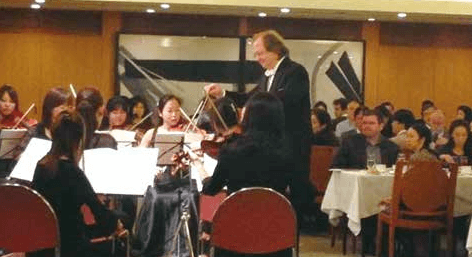Issue:
Creative ideas and determination keep Tokyo’s newest classical ensemble playing on

The menu that was served at the FCCJ’s classical music night included apfelkuchen and zweibel schnitzel, German specialties specially selected to enhance the theme of the concert serenades by composers Mendelssohn, Bach and Beethoven. The menu was carefully crafted by the Club and Tokyo Sinfonia, the orchestra that was featured that night. It was advertised as a dinner concert, a hallmark format of the orchestra for a program of music played between a service of three main courses. The evening featured beautiful music, an explanation of the serenades and the composers and sumptuous food.
After the final performance following the dessert, the musicians left their instruments by their chairs to mingle among the guests. The German ambassador was one member (invited as Chief Guest) of the sold out crowd testament to the popularity of the Tokyo Sinfonia philosophy of offering an experience that can be relaxing and fun.
The dinner concert was the brainchild of Canadian American Robert Rÿker, the conductor and music director of Tokyo Sinfonia. A professional tuba performer, the Maestro, as he is called, boasts a wide international conducting career including stints with the Montreal Philharmonic Orchestra and the Calcutta Symphony Orchestra. On stage, the veteran director exudes captivating warmth as he shares his views of the music with the audience. It’s this style of communicating with words and music that has won the Tokyo Sinfonia many accolades.
The chamber orchestra, composed of 19 string musicians mostly young, professional Japanese musicians has been holding regular performances at Ginza’s prestigious Oji Hall that are patronized by international embassies interested in sponsoring the music of their countries. The orchestra also invites internationally well-known musicians as guest artists; the most recent being Wenzel Fuchs, the solo clarinet of the Berlin Philharmonic, in July.
Rÿker’s first trip to Japan was in 1970. “I was so totally captivated by the Japanese hospitality that I worked hard to stay longer,” he says. In 1981 he returned as a member of the Montreal Symphony and stayed, conducting and performing in different orchestras. He then made further inroads into the lofty Japanese world of classical music through teaching and conducting numerous small orchestras across the country.
The decision to start an orchestra would seem to be a daunting one in Tokyo, a leading world capital known for its chiseled classical music talent and many world class orchestras. Rÿker recalls the day that marks the roots of Tokyo Sinfonia. It was after he had conducted a particularly riveting performance of Carmen in 2005, and three of the musicians came to his dressing room to tell him they wanted to play for him. “I was totally delighted. Conductors usually do not permit musicians into their room. But I am not one of them, and the bold decision by the players to visit and talk closely with me led to this remarkable idea to start our own orchestra,” he said.
The survival of the Tokyo Sinfonia, launched the next year, is a story about the solid commitment and enduring ingenuity of Rÿker and his supporters. “The available niche was for an intimate sound warm and expressive that could be done through string music,” he explains. Tokyo Sinfonia soon grew a reputation for creating a unique musical experience. The secret was not only the musical arrangements under the Maestro’s baton but also the ability of the orchestra to communicate with the audience in a variety of creative ways. One delightful example is the champagne, donated by the orchestra sponsors, that is served in the lobby of the Oji Hall for guests after the performance. The evenings continue with the audience mingling with the players, an arrangement that has become an admired signature of the organization.
Rÿker has carefully nurtured his players to become musicians able to reflect the expressiveness of the ensemble. For this, he says, he regards each of his players as soloists respected for their individual expression. “Japanese musical students play with technical accuracy based on an education that focuses on how to win competitions.” But for Rÿker they have to play emotionally and be able to communicate their passion to the audience. To pave the way for this expression, he regards team work as the key tool. The orchestra members, there fore, spend a lot of their time with each other, sometimes visiting onsen together with their families to tighten the bond. They work for a single goal creating music to touch the people. “The players are incredibly loyal to me and I to them,” he says. “The base is rock solid.”
On the financial side, too, Rÿker has displayed a “renaissance” spirit. He has reached out to admirers of the orchestra, now a non profit organization, and developed strong ties with embassies and corporate sponsors. An experienced business promotiontor raises funds for the orchestra activities, and has found probono supporters to provide things like the logo or technological assistance. Another area where the orchestra is making headway is performing at corporate events, such as fireworks nights on the bay. “With just 19 players we are portable,” pointed out Rÿker.
Now he is planning for a future that involves children by offering musical appreciation programs in schools. One fan letter from one audience member reads: “I thought the music, the orchestra and the audience were all enjoying themselves, and lifting each other up.” That statement, he points out, aptly captures the extraordinary experience of launching and sustaining an orchestra in Japan.
Suvendrini Kakuchi is a Sri Lankan reporter for Inter Press Service, and a regular commentator for Japanese publications and television.

